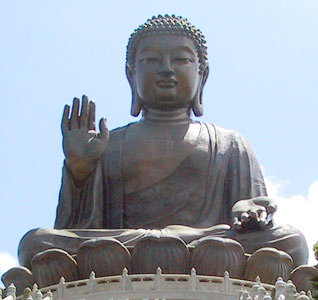Many religions have images of their gods. Many do not. How are we to interpret the image of a Buddha?
Well the problem at least for Buddhists is that Buddha's are neither "out there" in the world, nor "in here" within me.
That may come as a surprise. Its customary to believe that Gods are either "out there" either "in" the cosmos or "outside" the cosmos as creators. Or Gods are inside us and we discover our "true self."
In the film Human Traffic, Danny Dyer makes this apparently profound realisation:
The emperor wants to control Outer space. Yoda wants to control Inner space.
The problem is that Buddha teaches "middle path." If you go to extremes you have walked off the path that leads to enlightenment. If you think the Buddha exists out there in the universe, you have walked off the path. If you think Buddha lives inside you, you have also walked off the path.
I don't know why this video ends at the interesting part but when Monkey tries to get outside Buddhas palm he flies to the 5 pillars at the edge of the universe and in typical disrespect urinates against them. Only then does the Buddha reveal they are just his fingers. You cannot get outside the Buddha. We are therefore inside Buddha, which suggests Buddha is at least outside us, if not throughout the universe.
I remember in a Zen film someone asking about the Buddha. The Zen master referring to a handful of sand, said that Buddhas are as numerous as the grains of sand, and yet the handful was also Buddha. An Indra's Jewel Net like analogy. Both inside and outside.
Ok all these analogies only really make things confusing. Which is not bad, its better to be unsatisfied with confusion than to become satisfied grasping at the wrong thing.
The thing about the Buddha statue is that Buddha is outside you. He is to be respected and admired as the attainer of complete and perfect understanding and wisdom. As Buddha said on his enlightenment "I realised that the spiritual path was at an end, there was nothing left to attain." A complete resolution to the struggle of life. Go Buddha!
But that is only half. On the other hand each of us is Buddha. We are all connected to Buddha in that we are cut from the same block as him. We all have the seed that will grow under the right conditions into perfect resolution. The statue of Buddha is a mirror reflecting our own true self.
But we mustn't go to either side. That self that is reflected is not realised yet. There is work and growth to do.
Now even that isn't quite true. Our suffering and state of ignorance is itself not entirely real. It is only a belief or false vision that "I am ignorant" or "I am enlightened" that persists. When we stare in the mirror and see a sad and suffering being looking back, that is not really us. Its not that there is someone else hiding underneath either. Its that this being we see in the mirror, which is very real, has no "us" inside! The suffering only arises because we hold onto a self upon which the suffering can manifest. When life is difficult it is difficult for "me." When life is good, it is good for "me." When we are happy in a mundane way, suffering hasn't ended in a big way, its just that a particular suffering has ended. No holding onto "me" then there is nothing there to find life difficult or good. Life can be difficult or good, without it belonging to any thing.
And this really is how is the issue of "inside" or "outside" occurs. It really means inside or outside "me". Me is the issue.
But we seem so sure about "me". Where is "me"? "I am over here" we say. But isn't that a circle? Isn't "here" where I always am. Have we ever been anywhere else but here? If we are always here then it is pointless to say I am here. We shout to someone "I am here" but its not saying anything, we could just shout "Hear me" and the person would still look over and see us regardless what we say. So we are not here. That may be surprising. Things just are. Adding "here" adds nothing. Adding "me" adds nothing.
And that is getting to the middle.
When we look at a Buddha statue it reminds us of Buddha. Buddha means something indefinable and ungraspable. We may have attached to it being a perfect version of "me" and feel it imbued with our own personality and reality. Or we may have come to think of Buddha as some untouchable supernatural entity far off in the universe. We look at the statue and we drop both views. Around the perfect Buddha we see the clothes we have been trying to dress him. The wrong views of personal identity, or objective supernatural being. The statue should cause us to drop all these views and let all grasping for solidity and certainty fall away. How ironic when the statue is built of the most solid thing: stone! The certainty is that whatever solidity we are grasping for is wrong path.


No comments:
Post a Comment